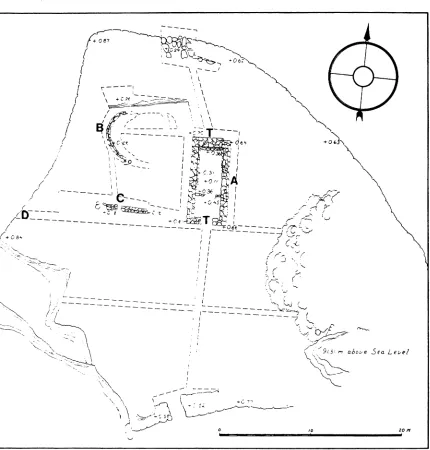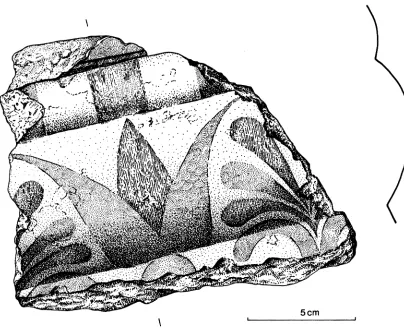(PLATE 13)
T HE SANCTUARY OF APOLLO PYTHAEUS at Asine in the Argolid is archaeo-
logically documented as existing already in the third quarter of the 8th century B.C.1 In the early period the architectural focal point within the temenos (Fig. 1) on the Barbouna hill was a simple, apsidal structure on a narrow stone socle. This building, B, had walls of pise or mud brick, as indicated by burnt lumps of clay retrieved during excavation, and a thatched roof. Associated pottery dates the destruction of the building to around 720 B.C. Building A was erected slightly further east. Its early history is somewhat obscure, as pot- tery found in the trenches by the walls only gives a terminus post quem for its erection at the end of the 8th century. On the other hand, nothing contradicts its being an immediate suc- cessor of Building B. If we suppose that A was constructed at the end of the 8th century, it must have been rebuilt a number of times. In its later phase the socle, 0.8 m. wide (1.0 m. at the north end), carried mud-brick walls as shown by fragments of burnt clay.2
The excavators in the 1920's note in the diaries "large quantities of tile fragments" inside the structure and, underneath this layer, "black matter", the charred remains of the woodwork of the roof. Further, by the outer wall of the northern short end a deposit of tiles of different kinds, both roof tiles and sima fragments, is reported. Fragments of the sima lay by the door at the south end. Of the apparently vast amounts of terracotta pieces found during excavation, few now remain. Illustrations in the notebooks enable us to identify where some of the extant fragments were actually found (Fig. 1 :T). Pieces of both Laconian and Corinthian tiles can still be found on the Barbouna terrace, but the question is how they should be related to the excavated structure A. Roofs were not necessarily laid consistently in one system or the other, or the Asine temple may have had an earlier, less pretentious,
1 The remains on the top terrace of the Barbouna hill were investigated during two brief seasons in the
1920's, in 1924 and 1926. In the publication by 0. Fr6din and A. W. Persson (Asine, Results of the Swedish Excavations 1922-1930, Stockholm 1938, pp. 147-151) however, the material was not given quite the atten- tion it deserves.
A complete study of the sanctuary and the related fortifications on the Barbouna hill is forthcoming as [Wells] Asine III, i in the Skrifter utgivna av Svenska Institutet i Athen, series in 4?. In 1986 an initial presen- tation of the material was made at the A' Evv(8plo Apyo;LKc.V 7rov8Zv, held at Argos from May 30 to June
1. By mistake, however, the paper has appeared in flpaKTlKa P ALE0voV'g ? EVVE8plOV AE\o7ToVV?pYLaKWV
?7rrov82v, KaXaua,ra 1985, pp. 349-353.
2 A remark in a recent article by 0. Wikander (1988, p. 207) calls for a cautionary comment. I do not disagree with him in that tiled roofs certainly presuppose sturdy walls to carry their weight, but wide socles do not necessarily imply tile roofs. Early Greek buildings often present wide socles but certainly did not have these roofs. The instances are many and can most conveniently be studied in H. Drerup, Griechische Bau- kunst in geometrischer Zeit (ArchHom II, 0). On the other hand, if Building A was constructed in the late 6th century B.C. we could argue that the tile roof, then in existence, called for a wide socle.
K. Fagerstr6m, in his dissertation Greek Iron Age Architecture. Developments through Changing Times (SIMA 81), Goteborg 1988, p. 28, reaches the unfortunate conclusion that Building A was a stone-wall structure. The excavated remains belie such a contention. It should also be noted, as is evident from this paper, that the roof was gabled and not, as Fagerstr6m suggests, flat.
American School of Classical Studies at Athens is collaborating with JSTOR to digitize, preserve, and extend access to
Hesperia
(2;
. 3.
1'~~~~~~~~~~~~~~~~~~~~~~~~~~~4q
,;D -- M -'~
FIG. ; Plan ofthetopterraceoftheBarbouna . Adnotshet e
1S'=--ish Ecvtion 192 90 Stokhl 1938 fIg13
iD e\ X.t\\Xx:0e^e ee
1'\ __
(+0~~~~~ \ IV+
,,>~~~~~~~~~~~
t
\
\ N1~ O /o 2,0rfI'~ ~ ~ ~ ~ ~ '
FIG. 2. As 5382 in the Asine Collection at Uppsala. Drawing A. Grenberger
Laconian tile roof and a later, more elaborate, Corinthian one. On the other hand, the Laco- nian tiles may once have been associated with an ancillary building of humble character on the terrace.3 In the Nauplion Museum storerooms are kept a large piece of sima, 32.0 cm. long (P1. 13:a) and several pieces of tiles from the later roof, all found in 1924 by the north wall of the building. Among the material found in the 1926 excavation and now in the Asine collection at Uppsala are two pieces of sima, both catalogued as As 5382, found lying in the doorway at the south end of the building.4 The larger of these, 16.2 cm. long (Fig. 2, P1. 13:b, c), is of crucial importance for the reconstruction of the roof of the temple.5
3This was suggested to me by Dr. Nancy A. Winter and could very well have been the case: a large portion of the terrace remains to be investigated, as is obvious from Figure 1.
4The Asine Collection at Uppsala was created in the 1930's from the material donated to Swedish univer- sities by the Greek government; see, e.g., Frodin and Persson (footnote 1 above), p. 12.
The fabric of the sima pieces shows some variation, the Uppsala fragments being white (2.5YR 8/2) and the Nauplion one pale yellow (5Y 8/4), both with brick-red core and large, dark, brownish red grit and a white slip. A large tile fragment in Nauplion differs in that its fabric has a greenish tinge and black grit. The absence of visible mica is of sig- nificance. On the fascia and the ovolo are opposing friezes of lotus and palmette, and the astragal is stylized into squares, surface color alternating with blacks and reds, the colors of the friezes. The Nauplion sima preserves the complete height of 18.0 cm.
The two most important pieces of the sima here presented show features that reveal their positions on the gables. As we have noted, the Nauplion sima comes from the northern pediment, the flange indicating its placement on the slope at the spectator's right when facing the building. Greater interest, however, attends As 5382, found lying by the doorway at the south end and thus fallen from the south pediment. At the back of this sima piece (P1. 13:b, c) are the remnants of the attached horizontal base into which the corner akrote- rion was sunk and nailed into place. The nail hole pierces the base and continues slightly diagonally into the ovolo. As 5382 therefore also reveals the slope of the roof as 250. How- ever high the temple once was, its squatness seems assured from the inclination of the roof in the manner of the many small chapels scattered over the Greek landscape today.6
Simas closely resembling the Asine one have been found in several places, for instance at Olympia, Athens, and Delphi.7 The ovolos and astragals of the Olympia simas are more rounded than the Asine ones, while the ovolo of roof 45 from the tufa temple in the Mar- maria at Delphi is a trifle flatter. The closest parallel to the Asine sima, however, is Nau- plion Museum inv. no. 17282, which G. Hubner thought came from Tiryns.8 The Tiryns piece is slightly less tall, 16.5 cm. high. Huibner's date of ca. 500 B.C. should also be valid for
the latest roof decoration of the Apollo temple on the Barbouna hill.
The Asine sima is not of local manufacture. Although clay beds may vary considerably, even within a limited area, Asine pottery is micaceous whereas the Apollo temple sima lacks mica. The fabric both of the sima and of the tile fragments does, however, conform visibly with Argive products of similar date, and it therefore seems logical to seek the origin of the Asine sima in an Argive workshop.9 In the early 5th century B.C. human activity was again
increasing in the Asine area,10 which had been under Argive control since the end of the 8th century.11 But we may be fairly certain that the cult of Pythian Apollo was still highly
6 I wish to acknowledge my gratitude to Dr. Nancy A. Winter for drawing my attention to the significance of the piece in the Uppsala Collection.
I Olympia II, pp. 194-195; Tafelband, 1896, pls. 118:4 and 119:2 and 4. A similar sima was also found on the Athenian Akropolis: TdA I, p. 16, fig. 16. Le Roy, 1967, pp. 101-102 and 219-221, pls. 38, 102, 109.
8 Huibner, 1975, pp. 123-125 with fig. 4:b, pl. 66:2 and color pl. 8:1. Note that the piece is stored at Tiryns.
9 This became obvious to me during the first excursion after the conference as we visited the Argos
Museum.
10 Tombs datable to Late Archaic and Early Classical times were excavated at Asine in the early 1970's: B. Rafn, Asine, II, Results of the Excavations East of the Acropolis 1970-1974, vi, The Post-Geometric Periods, 1, The Graves of the Early Fifth Century B.C. (Skrifter utgivna av Svenska Institutet i Athen, 40,
24:6:1), Stockholm 1979.
l Asine was laid waste by Argos around 720 B.C., but even though the area no longer prospered or was
popular in the first half of the 5th century, or the two fragments surviving of Bacchylides' paean to this god at Asine would make no sense.12 After that, rapid decline may have set in. Except for a reference in Thucydides (v.53) to a conflict in the year 419 between Argos and Epildauros over Epidaurian failure to sacrifice to Apollo Pythaeus, our sources for the cult, archaeological as well as literary, become silent for the remainder of the Classical period.
BERIT WELLS
G6TEBORG UNIVERSITY
Department of Classics
Institute of Ancient Culture and Civilization
Vastra Hamngatan 3 S-411 17 G6teborg, Sweden
a. Fragment of sima, Nauplion Museum
b. As 5382, Uppsala, Asine Collection. (Photograph 0. Lindman)
j,su bae (h
.~~0 Lidmn

